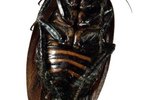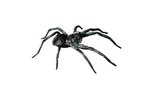
All spiders share a few basic traits, including number of body segments and limbs. The placement and function of their internal organs is likewise similar, although variances exist among species. All spiders produce venom and silk. These two abilities have numerous implications for spider behavior and habits.
Terminology
Physiology is study of functions and activities of living beings. Physiology depends on anatomy, the structures themselves. In essence, anatomy names and describes body parts, and physiology describes how they work. As such, spider physiology entails a lot of information about spider anatomy. Here are the basics: With few exceptions, spiders have two body segments, eight legs and two pedipalps. Most have weak vision, secondary to sense of touch, have open circulatory systems, and move via a combination of hydraulics and muscles. Spiders are generalists who've evolved to trap or hunt prey, thus accounting for a variety of species and behaviors.
Spider Bodies & Organs
All spiders have two main body parts: from front to back, a cephalothorax and an abdomen. The former of these is two fused sections -- head and thorax -- that include the brain, mouth, venom system and stomach. It's also where limbs attach. The abdomen contains the lungs, heart, reproductive system, spinnerets and digestive tract. Instead of internal bones, spiders have exoskeletons, which they shed and regrow as they get bigger and age. Spiders have open circulatory systems, which means all of their organs get oxygen from direct contact with fresh blood. Spiders breathe through a rudimentary trachea, book lungs or, more often, both. Normal movement provides enough energy to take in and expel air.
Spider Limbs & Motion
Spiders primarily interact with the world through their sense of touch. Their five pairs of limbs are quite sensitive to vibration and have specialized sensory hairs. Four pairs are legs; the remaining pair are pedipalps, shorter limbs near their mouth used in eating and mating. Spider movement involves a combination of hydraulics and muscles. As a spider's blood, called hemolymph, circulates, her legs extend outward. Muscles along each segment -- most spiders have seven on each leg -- pull them back into place. Faster movement requires faster blood circulation, which chokes off the spider's book lungs and oxygen supply. Luckily, most spiders' oxygen requirements are low enough they can handle sprints with no ill effects. Some spiders can shed limbs, usually as a last-ditch defense mechanism, but their mobility is compromised as they grow them back between instars.
Spider Eyes & Vision
Most spiders have six to eight eyes, although some cave-dwelling species have lost all of them. In many species, vision is rudimentary and sometimes limited to simple light detection. For wolf spiders, who hunt for their prey instead of waiting for them to get caught in webs, vision is more acute and refined. Unlike other arthropods, spiders and their arachnid compatriots have simple, camera-lenslike eyes. Other members of the class have compound eyes, akin to the multifaceted orbs of houseflies. In many species, a pair or two pairs of eyes are larger and more protrusive than others. The secondary eyes in many of these spiders have reflective layers that help spiders guide low-light situations. This comes in handy for the many spiders who are most active from dusk until dawn.
References
- California State University, Long Beach: Biology of Spiders
- Integrative and Comparative Biology: A Spider's Vibration Receptor -- Its Anatomy and Physiology
- California Institute of Technology: The Physiology of High-Order Visual Neurons in the Jumping Spider (Salticidae) and the Vocalization of Free Ranging Owl Monkeys
- Journal of Physiology: Resting Metabolic Rates of Two Orbweb Spiders -- A First Approach to Evolutionary Success of Ecribellate Spiders
- BBC: Inside a Tarantula Spider's Beating Heart
- Natural History Museum: Spider Biology
- FindASpider.org: Mobility of Spiders
Resources
- Advances in Insect Physiology: Spider Physiology and Behaviour, Vol. 40; Jerome Casas, ed.
- University of Florida; The Physiological and Biochemical Constraints on Activity in Spiders; Kenneth Neal Prestwich
- Washington State University: Not Everything Has a Reason
- Evergreen State College: Spiders and Scorpions
- Education Portal: Anatomy Versus Physiology -- What's the Difference?
Photo Credits
-
BananaStock/BananaStock/Getty Images



